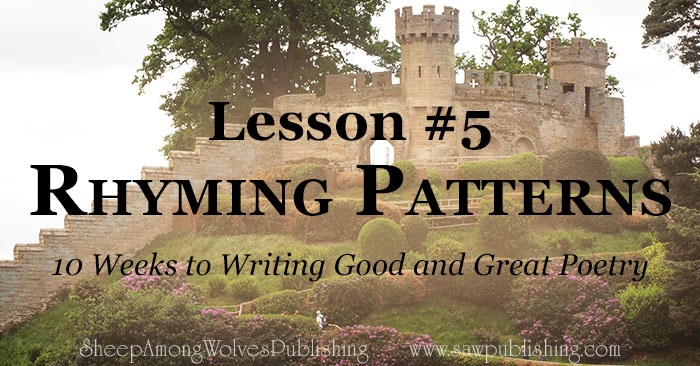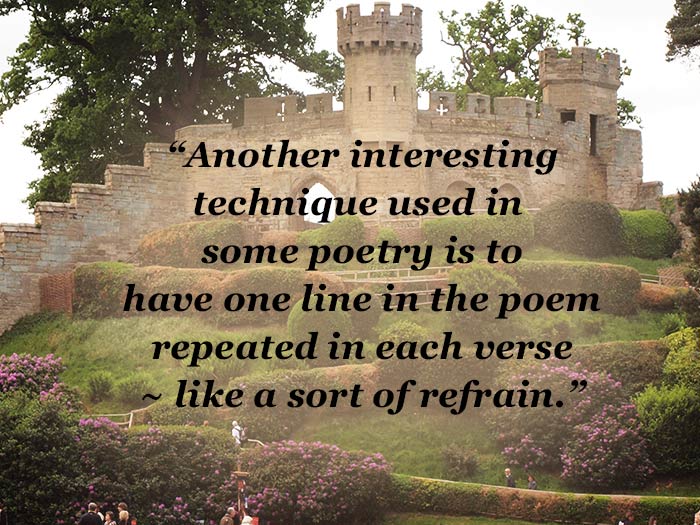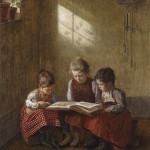The Role of Rhyming Patterns in Creating Mood
Sheep Among Wolves’ Good and Great Poetry Course was created to teach high school students how to write poems that are both good and great. This FREE 10-week course takes a look at some fundamental elements of poetical structure as well as the themes and subject-matter which really make up the soul of a poem. For a full explanation of the course, see our post entitled 10 Weeks to Writing Good and Great Poetry. To receive the course in 10 weekly email lessons, sign up here, or at the bottom of this post.

How much impact can a rhyming pattern really have on the tone of a poem? Of course, we need to use some kind of rhyming pattern in poetry, but does it matter which one we choose? Well, let’s think about how much impact a dress pattern has on the final product. To be sure, the dress pattern doesn’t change the colour of the fabric, the texture or the design, but it changes how the entire dress looks. Rhyming patterns are like that dress pattern. They don’t change the message, the overall theme, or even some of the words you use, but they change how that message and theme are viewed by your reader. They change the shape of the dress, and whether or not it suits the body of the poem which it has to fit.
So let’s take a look at a few rhyming devices which can change the shape of that poem.
Double Syllable Rhymes
One tool which can be used in rhyming patterns is a double syllable rhyme. Words like “sorrow” and “borrow” are double syllable rhymes, as is “tomorrow” even though there are three syllables in the word itself. Double syllable rhymes can improve the flow and pace of a poem, speeding the reader along because of how smoothly those rhyming words read. These rhymes are especially useful in long lines of poetry, where they are less likely to cramp the reader into wasting a line merely on the rhyming word.
Many beautiful hymns are written with this type of rhyme, including “Glorious Things of Thee are Spoken.”
Glorious things of thee are spoken,
Zion, city of our God!
He, whose Word cannot be broken,
Formed thee for His own abode.
On the Rock of Ages founded,
What can shake thy sure repose?
With salvation’s walls surrounded,
Thou may’st smile at all thy foes.
See! the streams of living waters,
Springing from eternal love;
Well supply thy sons and daughters,
And all fear of want remove:
Who can faint while such a river
Ever flows their thirst t’assuage?
Grace, which like the Lord, the giver,
Never fails from age to age.
Round each habitation hov’ring,
See the cloud and fire appear!
For a glory and a cov’ring
Showing that the Lord is near.
Thus deriving from our banner
Light by night and shade by day;
Safe they feed upon the manna
Which He gives them when they pray.
Savior, if of Zion’s city,
I through grace a member am,
Let the world deride or pity,
I will glory in Thy name.
Fading is the worldling’s pleasure,
All his boasted pomp and show;
Solid joys and lasting treasure
None but Zion’s children know.
The double syllable rhymes in this hymn give a satisfactory ring to the poem, and create a sense of continuity throughout the entire poem. Notice, however, in stanza three, how this hampers the author into using two words (banner/manna) which don’t quite rhyme, although John Newton’s English accent is a little bit of an excuse. Some words have more options in the rhyming department, while others leave the author in somewhat of an awkward situation. If you write about “waters,” as in this hymn, you are going to have to make a miraculous recovery to slip in “daughters” naturally. (Or else, “totters,” if you like.) Or, if you use “bubble,” don’t forget that one of its only appropriate rhymes is “trouble.”
Sets of Three Rhyming Words
Having three lines in a given verse that rhyme with each other, is a great way to bring continuity to the whole piece. The stanza is more tightly knit together if you draw in more rhyming words, than if you leave lines unrhymed. This is especially true of sets of three rhymes, whether they come in a row, or are divided by another line, which will usually have its own rhyming match somewhere else in the verse.
In “Rise, Glorious Conqueror” we find the most common rhyming pattern of this type.
“Rise, glorious Conqu’ror rise
Into Thy native skies;
Assume Thy right;
And where in many a fold
The clouds are backward rolled,
Pass through those gates of gold,
And reign in light.”
As well as the set of three rhymes in lines four through six, we have two other pairs of rhymes, one of which has a similar feel to the set of three. Because of the complex rhyming pattern, the whole verse is closely tied together. Incidentally, this also helps in remembering hymns. Where the lines all rhyme with at least one other, you are less likely to forget one line out of a given verse—because if you remembered it’s rhyming pair, you can probably figure it out.
Rhymes Within a Line
Rhyming words that fall in the middle of the line to rhyme with the ending word can produce the same precision as we talked about regarding shorter lines in lesson four—because it’s essentially the same thing! A couple of advantages to this device are that the rhyming words can be closer together in one line than in two—that is, by number of syllables—and also, that the flow can be smoother and less choppy than with many short lines. It gives less emphasis to the rhyming pair than when they appear at the ends of two lines, and allows it to flow a little more naturally.
A wonderful example of rhymes within lines, is Longfellow’s “I Heard the Bells on Christmas Day,” which shows how smoothly and seamlessly this type of rhyme can be used.
I heard the bells on Christmas day
Their old familiar carols play,
And wild and sweet the words repeat
Of peace on earth, good will to men.
And thought how, as the day had come,
The belfries of all Christendom
Had rolled along th’unbroken song
Of peace on earth, good will to men.
Till ringing, singing on its way
The world revolved from night to day,
A voice, a chime, a chant sublime
Of peace on earth, good will to men.
And in despair I bowed my head
There is no peace on earth, I said,
For hate is strong and mocks the song
Of peace on earth, good will to men.
Then pealed the bells more loud and deep:
God is not dead, nor doth He sleep;
The wrong shall fail, the right prevail
With peace on earth, good will to men.
The rhyming words almost slip in unawares in the third line, as if the author put them there by accident. I always think that those very rhyming words help to “roll along th’unbroken song/Of peace on earth, good will to men!”

Rhyming with a “Refrain”
Another interesting technique used in some poetry—especially hymns—is to have one or more lines in the poem which are repeated in every verse, like a sort of refrain that rhymes with a different word in each stanza. “All Hail the Power of Jesus’ Name” is a good example of this pattern. The second line of the verse always ends in something rhyming with “all” and the fourth line is a refrain which includes that word. A variation on this pattern is where the rhyming word and the line or lines following are a type of refrain, and only the previous words change. In “Jesus, Thou Mighty Lord,” we see this displayed quite well.
“Jesus, Thou mighty Lord,
Great is Thy name;
Still through eternal years,
Thou art the same;
Changeless Thy holy Word,
True, evermore;
Thy Name we glorify,
Thy Name adore.”
The last two lines remain stationary for the entire hymn, and in the line preceding them only the first word changes. In verses two and three it changes to “shines evermore” and “Thine evermore,” which gives a very interesting and pleasant sound to the hymn when you sing it.
Choosing the Right Pattern
Sometimes choosing a dress pattern can be easy. You go to the fabric store and look over the selection of patterns, and see one which you think will be just perfect. You bring it home, you cut it out, and when you sew it together, it is perfect. But sometimes it can be a lot harder than that. Sometimes the pattern will need alteration to fit you, because it was designed to fit most people of your size, and not you in particular. This is the same with rhyming patterns. Sometimes a standard rhyming pattern will work just perfectly, and show off your poem to perfection. Other times you will need to alter it, to put a dart in here, and take a half-an-inch off the hem there—and that’s okay. It means that you are paying attention to the needs of your poem, and adapting your rhyming pattern accordingly. You are finding the right pattern for you. Because choosing the best pattern, and cutting it out just right, can change the entire shape of what you have to say.
To receive a PDF of the assignment for this lesson sign up below.
How To Sign Up
All ten poetry lessons can be found by clicking on the Poet’s Corner tab in the menu. If you would like to receive the course assignments as well, you can sign up below to have the lessons and assignments delivered by email over a ten week period.
This post may have been shared with the following linkups: The Art of Homemaking Mondays, Monday’s Musings, What Joy is Mine, The Modest Mom, Homemaking Wednesdays, Wise Woman Linkup.
You might also like:

Maxwell Perkins once wrote that, “Most of the best books in the world are read by both children and adults.”

Children like to memorize poetry which is easy to recite, and contains a lesson or object they can understand.

